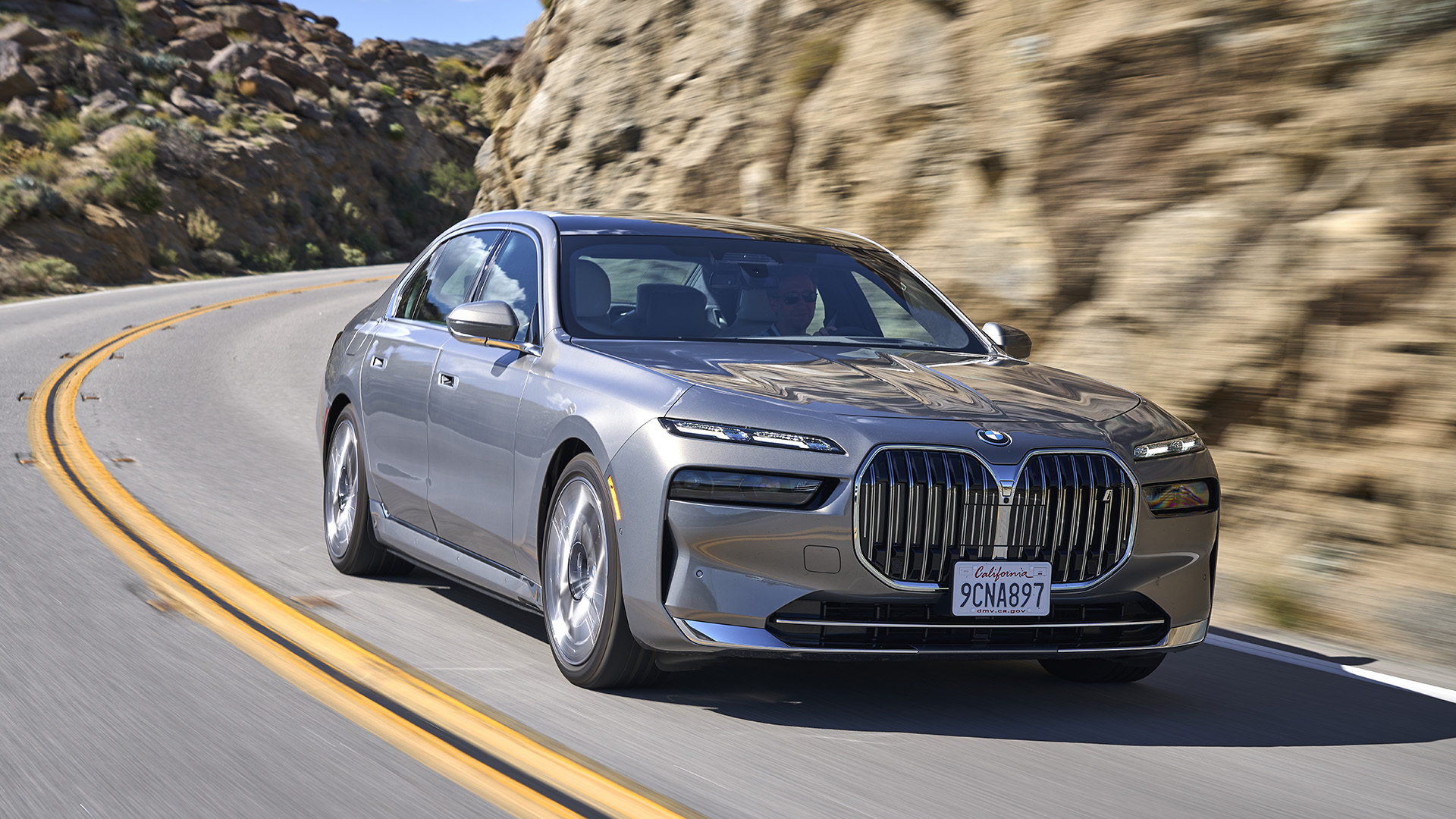

Some cars are designed to be driven, while others are designed to be driven in. The BMW i7 is both. This long-awaited luxury sedan provides an elevated experience whether you’re sat in the driving seat or in the rear. It’s part of a complete overhaul of the 7 series range which also sees new petrol and diesel models, as well as hybrids.
The i7 is every bit the 7-series car and aside from the engine, is identical to the other new editions. As BMW’s top-of-the-range saloon car, it appeals to a very select audience. This is a vehicle which is used by businessmen and VIPs, with the owner often sat in the back, while a driver takes the wheel, though not exclusively.
BMW has designed the new 7-series to give the very best driving experience, so when you’re behind the wheel it responds with the precision and power of its sportier vehicles. This allows it the benefit of being as fun to drive as it is to chill out in the back. For those in the rear, there are not only reclining and massaging seats but also an incredible 31-inch cinema display to keep you occupied.
The first BMW 7 series was released in 1977. Since then there have been six generations of the car, with the seventh being this new line-up. It’s BMW’s flagship car, the very peak of its motoring abilities and has been the launch pad for many of its best technologies. It is on the 7 series where the iDrive system was first introduced in 2001, the first Xenon headlights in 1986 and the first with ABS in 1977.
The seventh generation 7 series is the first to feature a 31.3-inch theatre screen display in the rear and will be the first to feature Level 3 autonomous driving abilities when it becomes available (currently advanced Level 2). The new model comes solely in the long-wheel-base form and a choice of three main engine types: petrol or diesel internal combustion engines, plug-in hybrid (PHEV) or the all-electric power system that is the i7.
I spent a couple of days behind the wheel of the i7 to properly experience both the driving abilities of this vehicle and what it feels like to be chauffeur driven in.
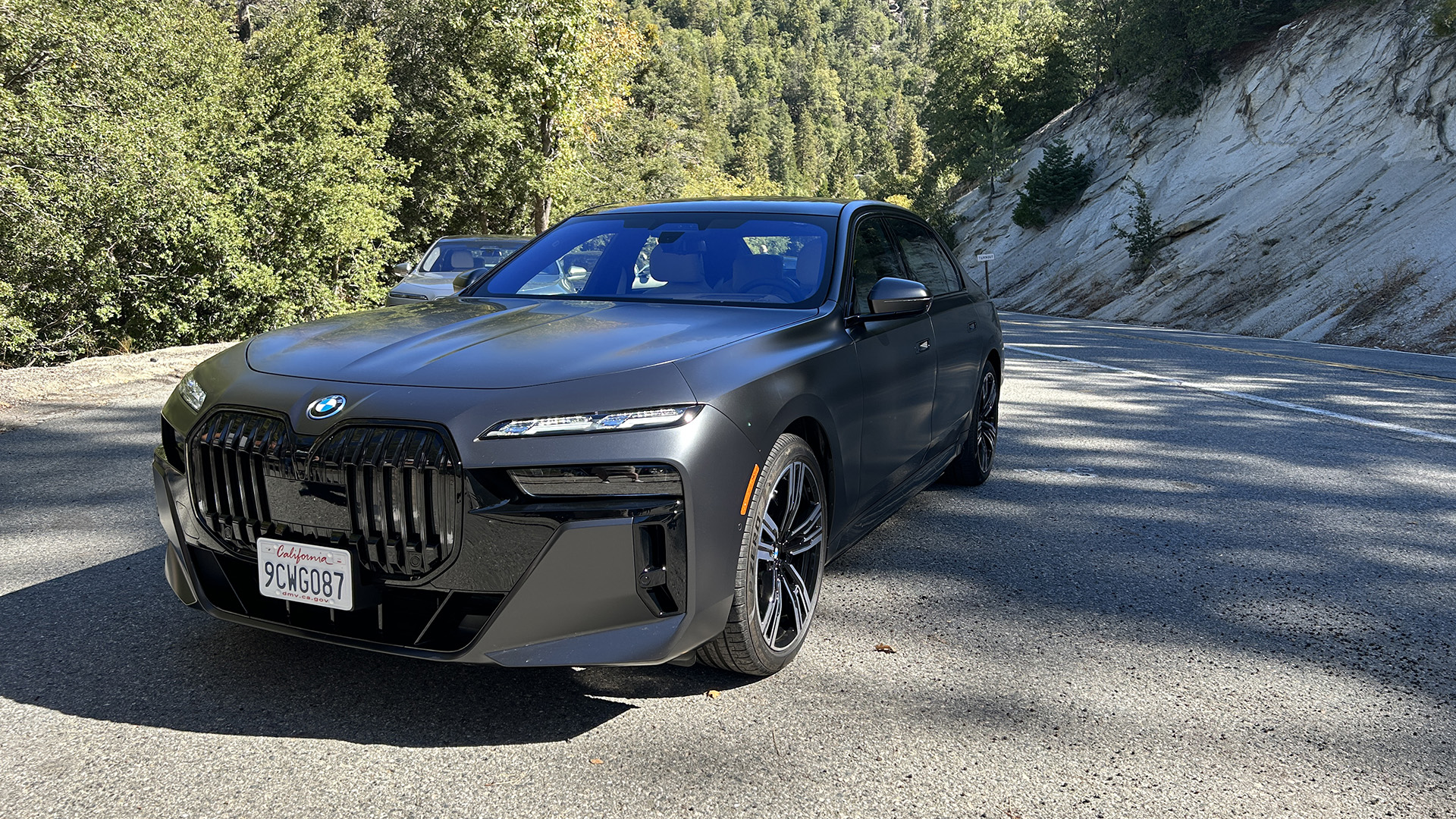
BMW i7 in Frozen Deep Gray
Suited and booted – the i7's looks
The appearance of the new 7 series has been divisive. BMW has leaned in hard to the elongated kidney front grill that appeared on the i4 and iX models, like two flared nostrils. While this was broken up by a front numberplate on the previous models, in the 7 series it sits uninterrupted.
Sign up to the T3 newsletter for smarter living straight to your inbox
Get all the latest news, reviews, deals and buying guides on gorgeous tech, home and active products from the T3 experts
There’s also a new headlight arrangement here. The all-day LED lights sit higher and separate from the main headlights. In the day, this allows the main headlights to largely disappear into the bodywork, leaving just the narrow LEDs on show.
The result is a meaner and more modern look to the car. It’s one I wasn’t sure about when I first saw pictures but like the i4 and iX, in person, it looks impressive. The i7 comes in a choice of alpine white, 10 different metallic colours and two of what it describes as ‘frozen’ colours. These are matte tones, much like a premium wrap, with the dark grey version in particular looking incredible. For something a bit different, it also comes in a tone-tone combination. This has an almost Rolls Royce feel to it (a company that BMW has owned since 2003), making the car look even grander but modern at the same time.
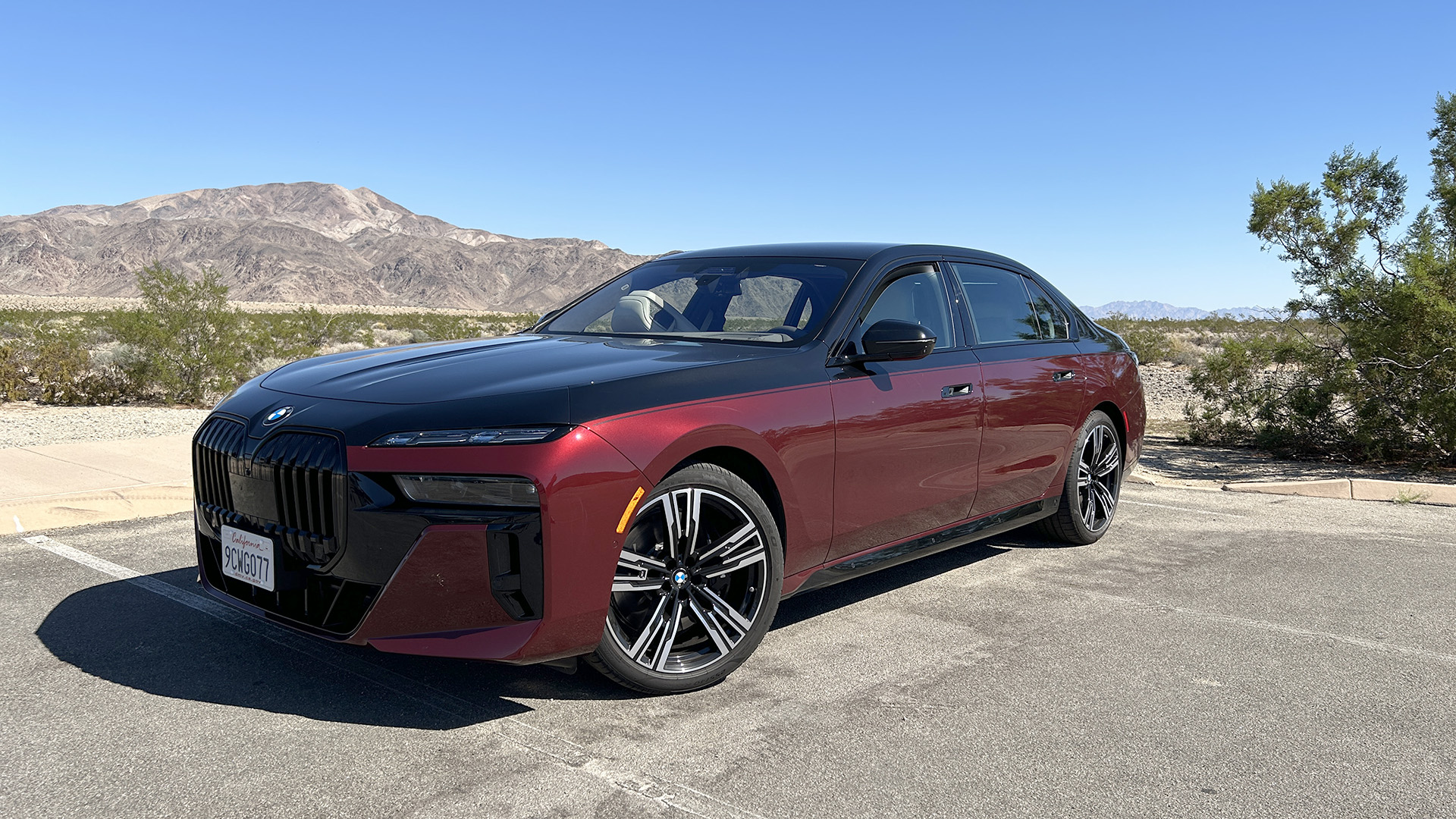
BMW 7 series in two-tone finish
As standard, the i7 sits on 19-inch rims but has options for 20 and 21-inch upgrades. Inside, there’s a choice of Veganza leatherette or Merino leather colours, plus either oak, ash or piano black trims.
The BMW i7 is definitely a head-turner in any configuration. When driving through traffic it certainly attracted attention and looked imposing when parked. A flagship car should make an impression and this car certainly does that.
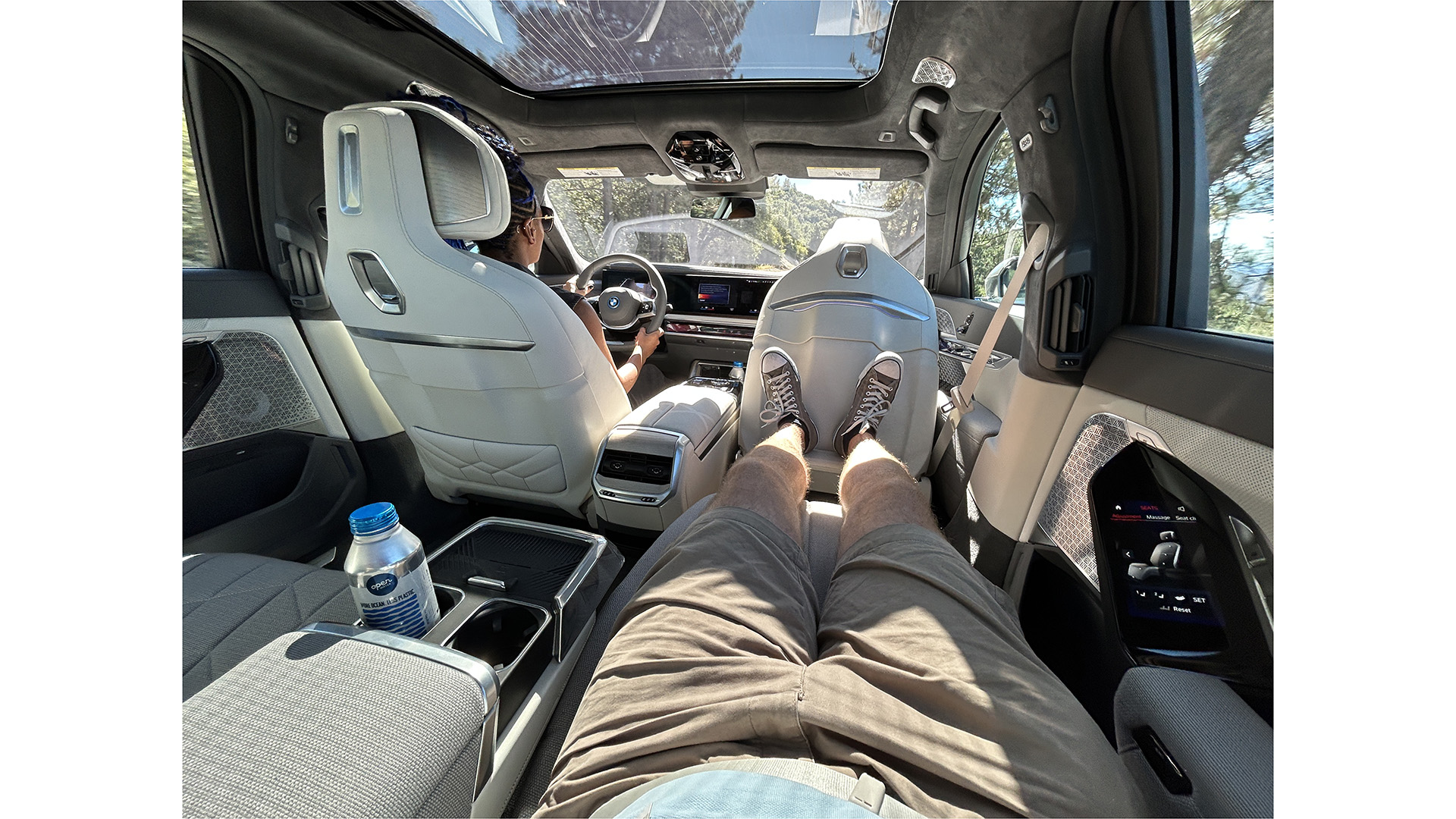
Stretching out in the back of the BMW i7
In the back seat of the i7
The best seat in the i7 is in the rear, on the opposite side to the driver. This is the prime passenger seat and gives you access to all the technology and the ultimate in comfort. Even entering the car is amplified by the auto opening doors, front and rear, so as a passenger, you don’t need to touch a thing.
Described as BMW’s executive lounge seating, the rear seats are large and comfy. The central armrest, when lowered, also contains cup holders and a tray for your phone. Mounted in the rear doors on both sides are 5.5-inch colour touchscreen displays that allow you to control everything from the temperature and seat position to the blinds and entertainment.
With a single press of the tablet, the blinds on the side and rear windows close, the glass panoramic roof blind closes and the gigantic cinema screen folds down. With another press, the passenger seat in front of me folds forward, my seat reclines and a leg rest extends, putting me in the perfect relaxed position, ready to watch a bit of telly.
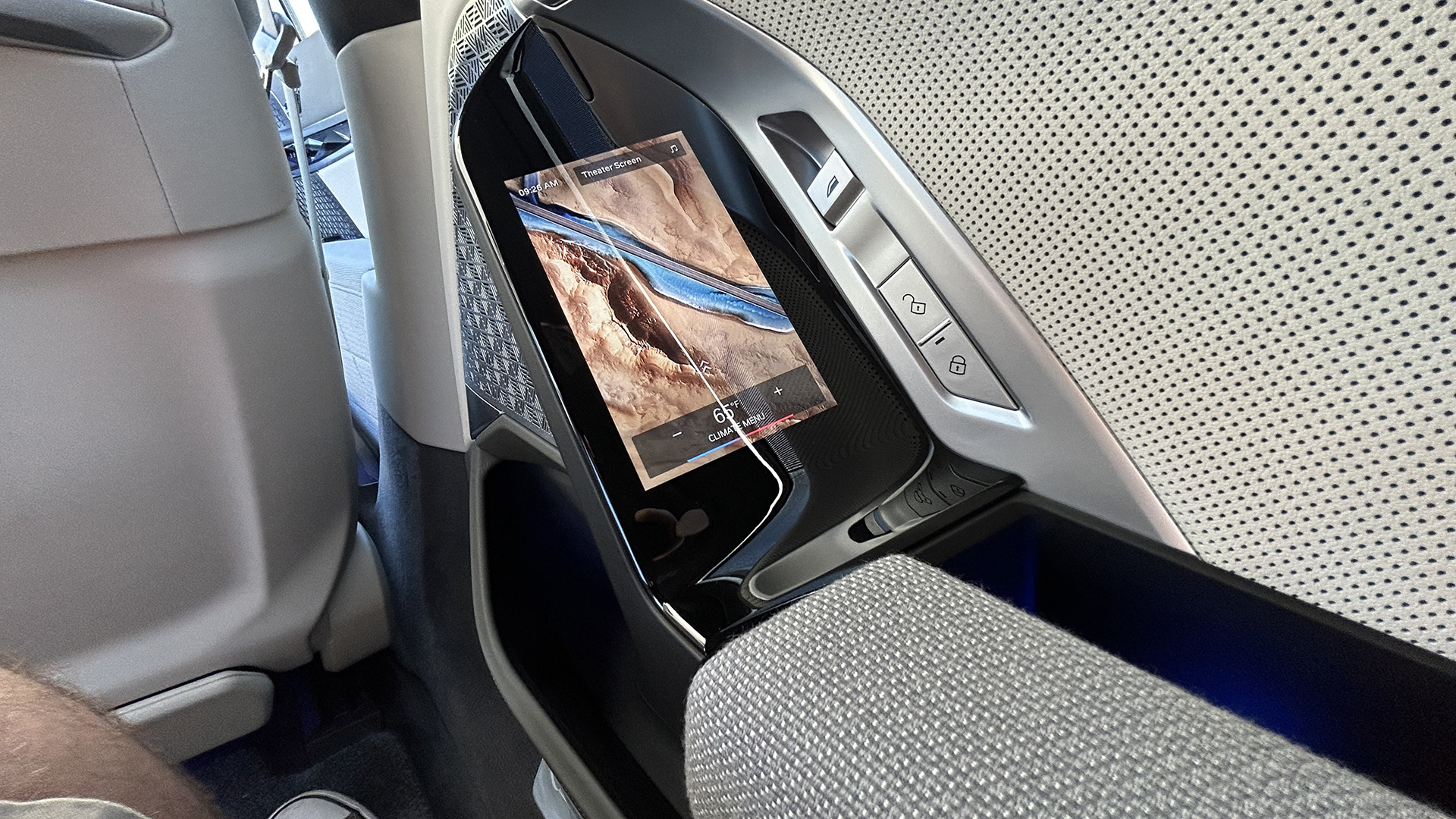
The 5.5-inch in-door tablets
While the other rear seat has all the same controls on its own tablet, you obviously can’t fold the driver seat forward the same way. There’s still plenty of room of course, just not the ability to put your feet up.
There’s a massage functionality built into both rear seats, to relieve the daily stresses on your trip home, and both heated and cooling options to ensure the temperature is just right. When you’re not watching the screen, the glass panoramic roof provides plenty of light into the cabin. However, if you do opt for the screen, even folded up this will block some roof light.
From the rear panels, you also have access to the i7’s MyModes. These include the Theatre Mode mentioned above but also Expressive, Relax and Digital Art. When selected they change everything from the ambient lighting to the info displays for the driver (so not something you’d want kids messing about with). They set the mood for the journey and everyone in the car with a simple press.
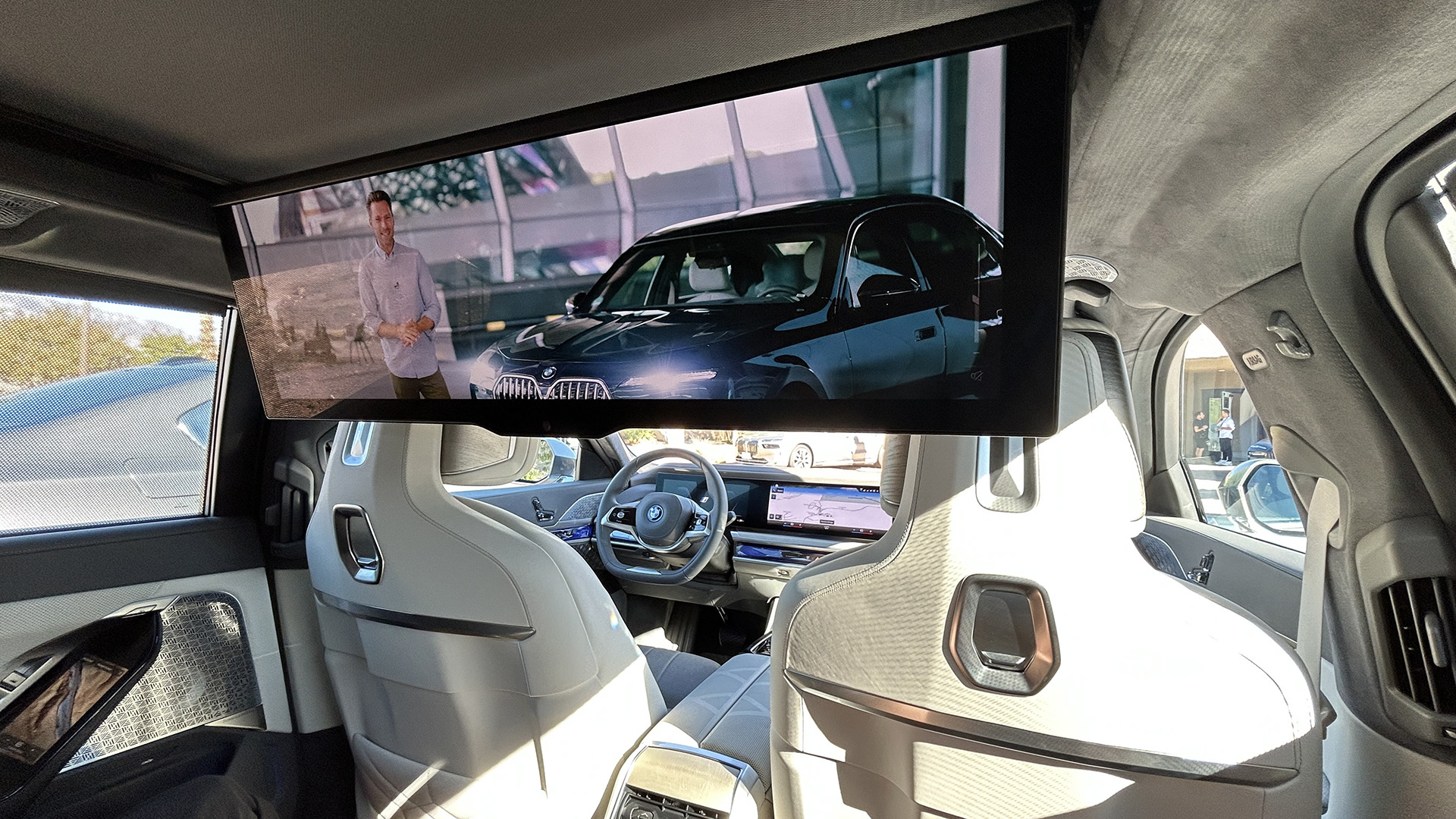
The 31-inch Theatre Screen in action
Cinema Display
As much as we can talk about the technology in the i7, the Theatre Screen display deserves special mention. This 31.3-inch display comes as standard as part of the Excellence Pro option, as part of the Executive Pack add-on, or a £4000 optional extra.
The 8K screen is in 32:9 format, which is like having two 4K 16:9 screens next to each other. That means for most content, the video has large bars on either side. That space is not wasted though. You can display the time and weather information to the side, or you can zoom the screen to fill the whole screen. Using the zoom, you can also position the content over to the left or the right, so that the video sits in front of you rather than in the middle of the car.
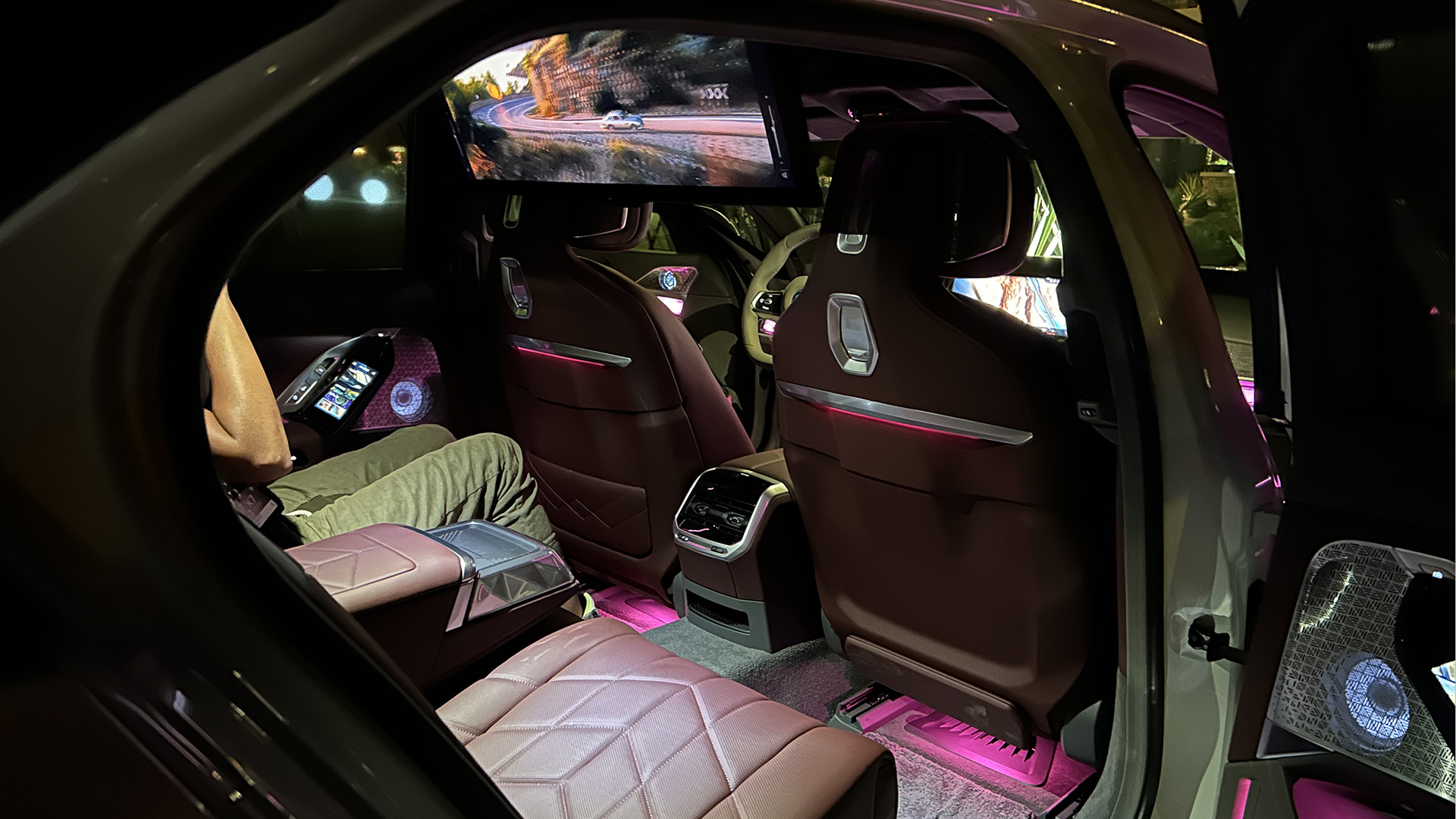
The Theatre System is powered by Qualcomm’s Snapdragon cockpit platform and has Amazon Fire TV built-in. Using the car’s inbuilt 5G Snapdragon modem you are able to stream content over the air from a range of streaming services. You can also download content in advance and save it on the system, which is handy if you’re driving through areas with spotty mobile coverage.
The screen is complemented with a Bowers & Wilkins 4D surround sound system, complete with 36 speakers and optional ‘in-seat exciters’ that provide a rumble of bass through the rear seats to give a full cinema experience. It’s an impressive experience, especially when you have that true 32:9 content, but even watching HD movies straight from Amazon Prime, it’s the ultimate in-car entertainment and now the only way I want to travel.
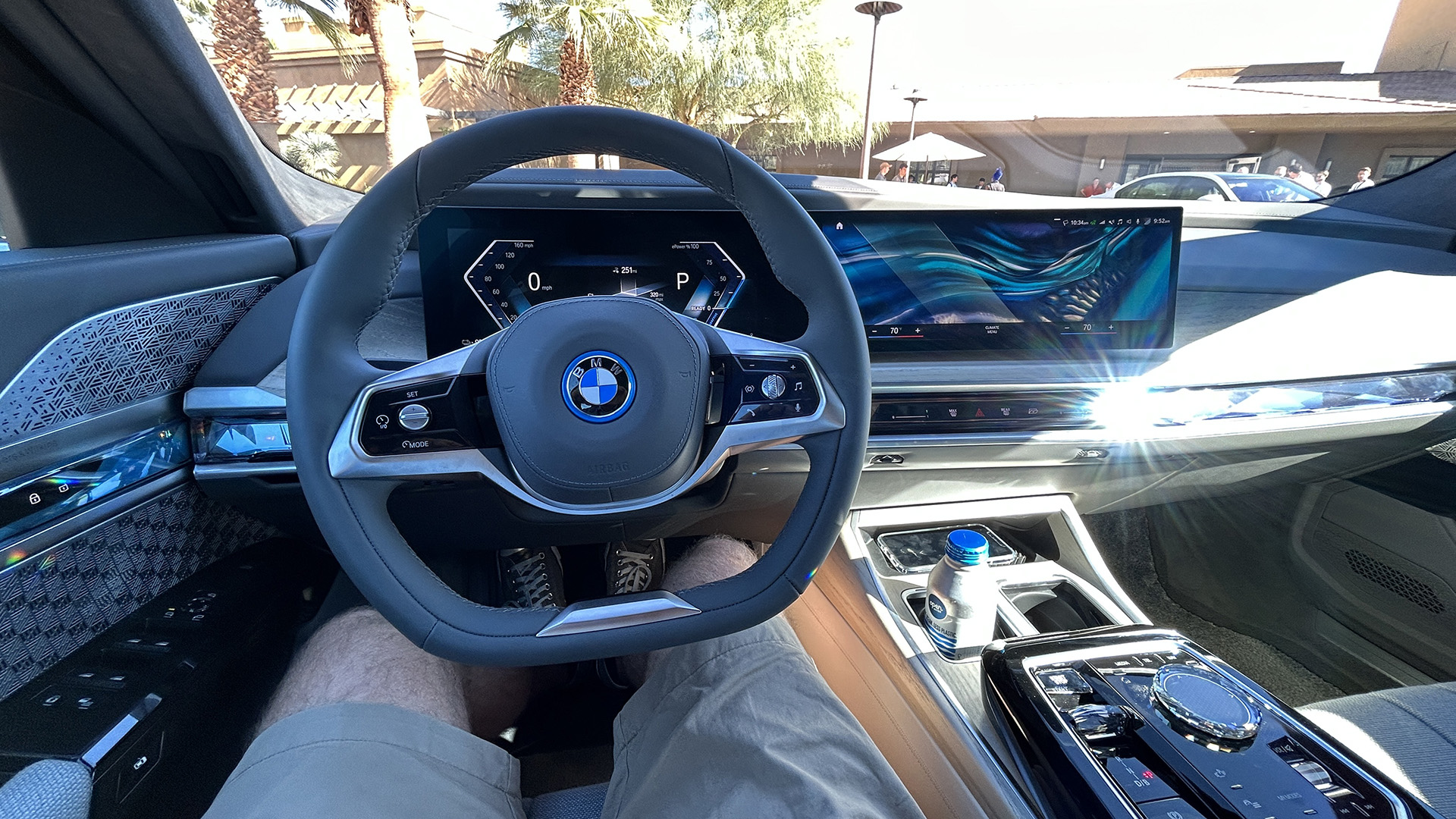
In the driving seat
There’s no lack of technology in the front seat of the i7 either. As much as there’s a focus on back-seat comfort, every effort has been made to make the driving experience equally impressive.
First, there’s the curved display, which incorporates a 12.3-inch info screen behind the steering wheel and a central 14.9-inch display. There are also touch-sensitive control panels to control the functions such as interior lighting, hazard warning light and air vents. The air vents themselves are hidden in the trim but additional touch panels for speed and direction sit in their place.
There are still buttons here though. The central console houses the iDrive controller, start/stop button, audio controls, gear selector and the MyModes button. On the steering wheel, there are easy controls for the info screen selection, head-up display, phone and audio.
The really clever technology though comes in the i7’s driver assistance systems. It uses 8-megapixel automotive cameras with Mobileye technology in addition to ultrasonic and radar sensors to provide optimal data from around the vehicle. The Driving Assistant Plus combines the Active Cruise Control with the steering and lane control to provide level 2 automation at speeds of up to 112mph. With the professional package, this can be extended to 130mph and includes traffic light recognition.
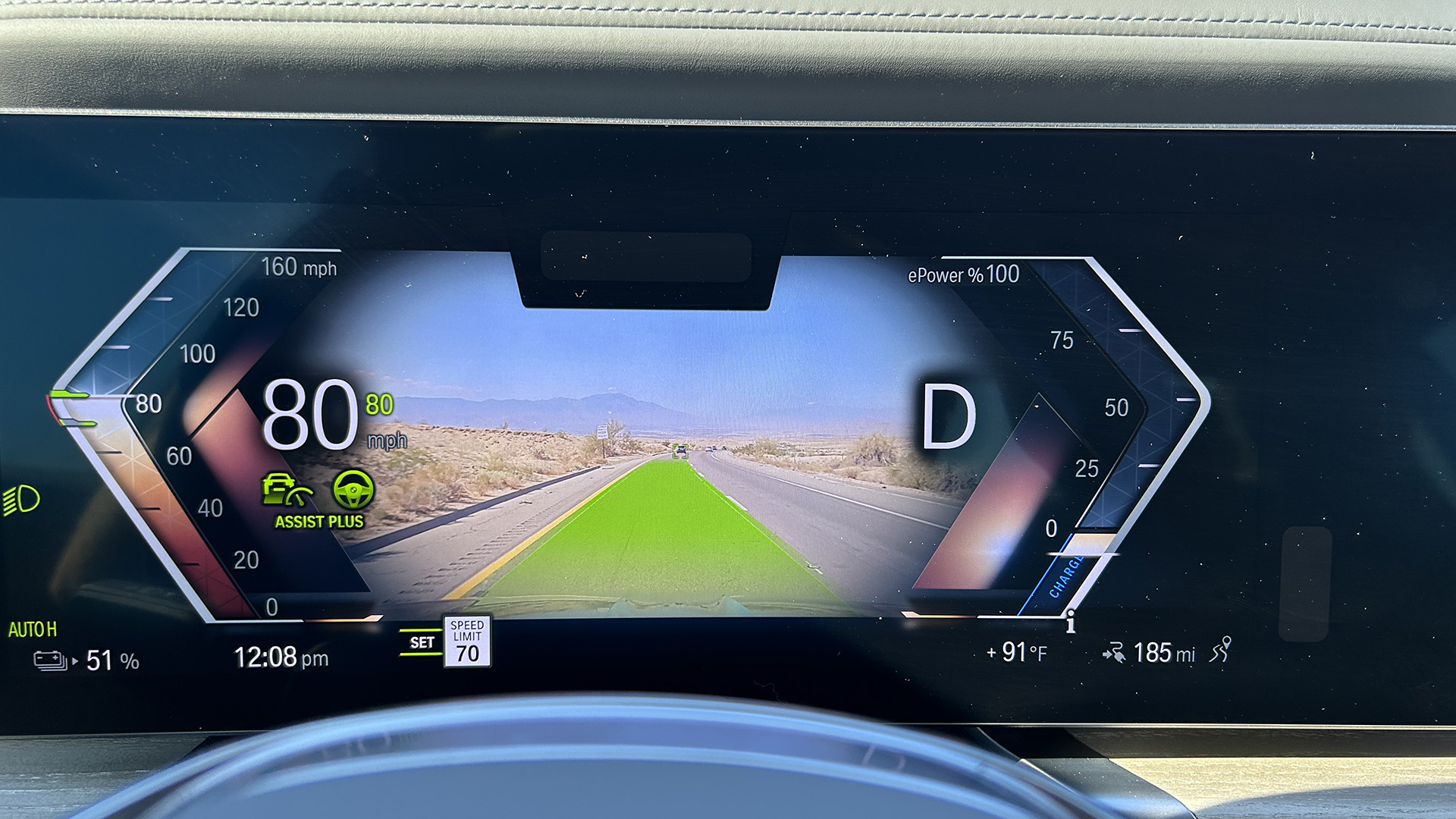
Active Cruise Control Plus in operation, shown on the info display
In North America, the Driving Assistant Plus actually lets you take your hands off the wheel on main highways at up to 81mph. The internal camera monitors your eye position though to make sure you are watching the road and warns you if you look away for more than a few seconds. Local restrictions mean this function is not yet available in Europe or the UK though.
As I was testing the i7 in the US, I got to try the full hands-free driving experience with the Driving Assistant Plus. Overall, I found that this version of the Driving Assistant is improved from the one in the i4 but the hands-free option really is a game changer for motorway driving. Even though you still need to focus on the road, taking your hands off the wheel feels more relaxing and the car does an excellent job of staying in the right lane and at the appropriate speed for the traffic in front.
As I mentioned, this car is also ready for level 3 automation, which would allow the driver to completely take their eyes off the road. This will be coming in Germany, providing full ‘hands-off, mind-off’ driving at up to 40mph in traffic. It is also expected to be available in China soon.
The driving tech doesn’t stop there, either. The Parking Assistant Plus comes with Drive Recorder, which uses the vehicle’s cameras to record video around the vehicle and use it for accident evidence and in the case of a break-in. The Parking Assistant Professional and Manoeuvre Assistant allow you to move the vehicle in and out of parking spaces automatically, it remembers previous manoeuvers, and even controls the car via your smartphone from outside the vehicle – like in those James Bond scenes.
Driving assistance aside, the i7 is just a really fun car to drive. For such a big and heavy vehicle, it handles like a much smaller car. The dual-axle air suspension and rear-axle steering, definitely play their part here. With Sports mode engaged the suspension and steering tighten and the lights on the dash change. Even around tight bends, it sticks to the road, in a way you wouldn’t expect from a long-wheel-based car.
If you’re driving the i7 with someone important in the back seat, there are a couple of things to be aware of, though. As soon as that Theatre Screen folds down your use of the rearview mirror is gone. And when that front passenger seat folds forward to allow the rear passenger to lie back, it can block the far wing mirror (depending on your seating position). Considering the rest of the tech on this car, I’m surprised there isn’t a digital rear-view mirror option here.
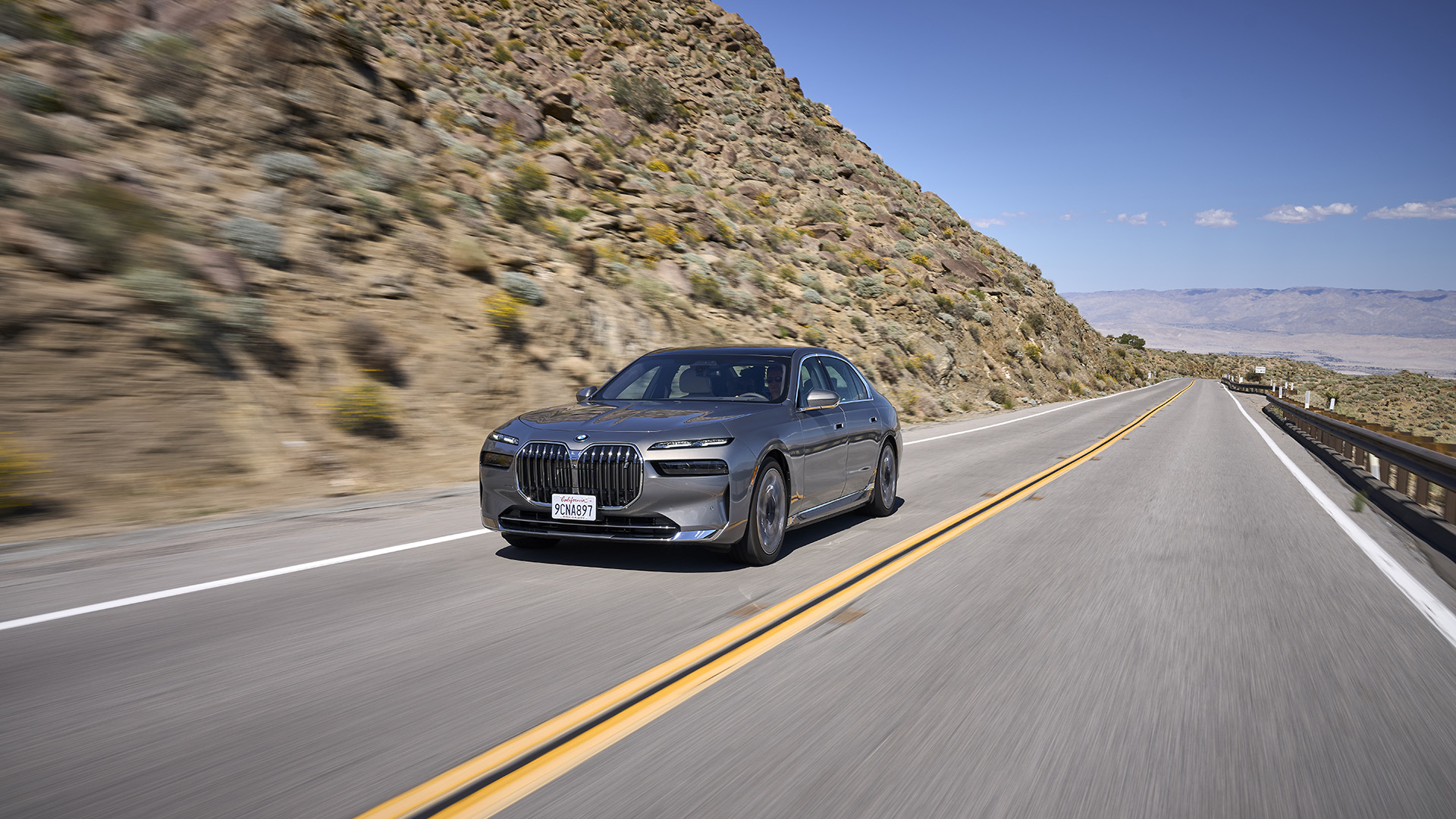
Range and performance
The i7 features dual electric motors, delivering an output of 400kW or 544hp. That provides 549lb-ft of torque and an acceleration of 0-62mph in 4.7 seconds, with a top speed of 149mph. For such a big car, this is really impressive. There’s also an i7 M70 on the way that is likely to offer even greater performance.
Designed for long-range use, having enough charge is important for the i7. The official ratings have its range between 318 miles (EPA) and 388 miles (WLTP). Real-world use is normally somewhere between the two, giving you around 350 miles on a full charge. Certainly in the UK, that’s more than you’d need for most journeys and with 195kW max charging, your time to refill is kept as short as possible. Mercedes’ direct competitor to the i7, the EQS, does offer a slightly greater 350-450 mile range, though not at the same level of performance.
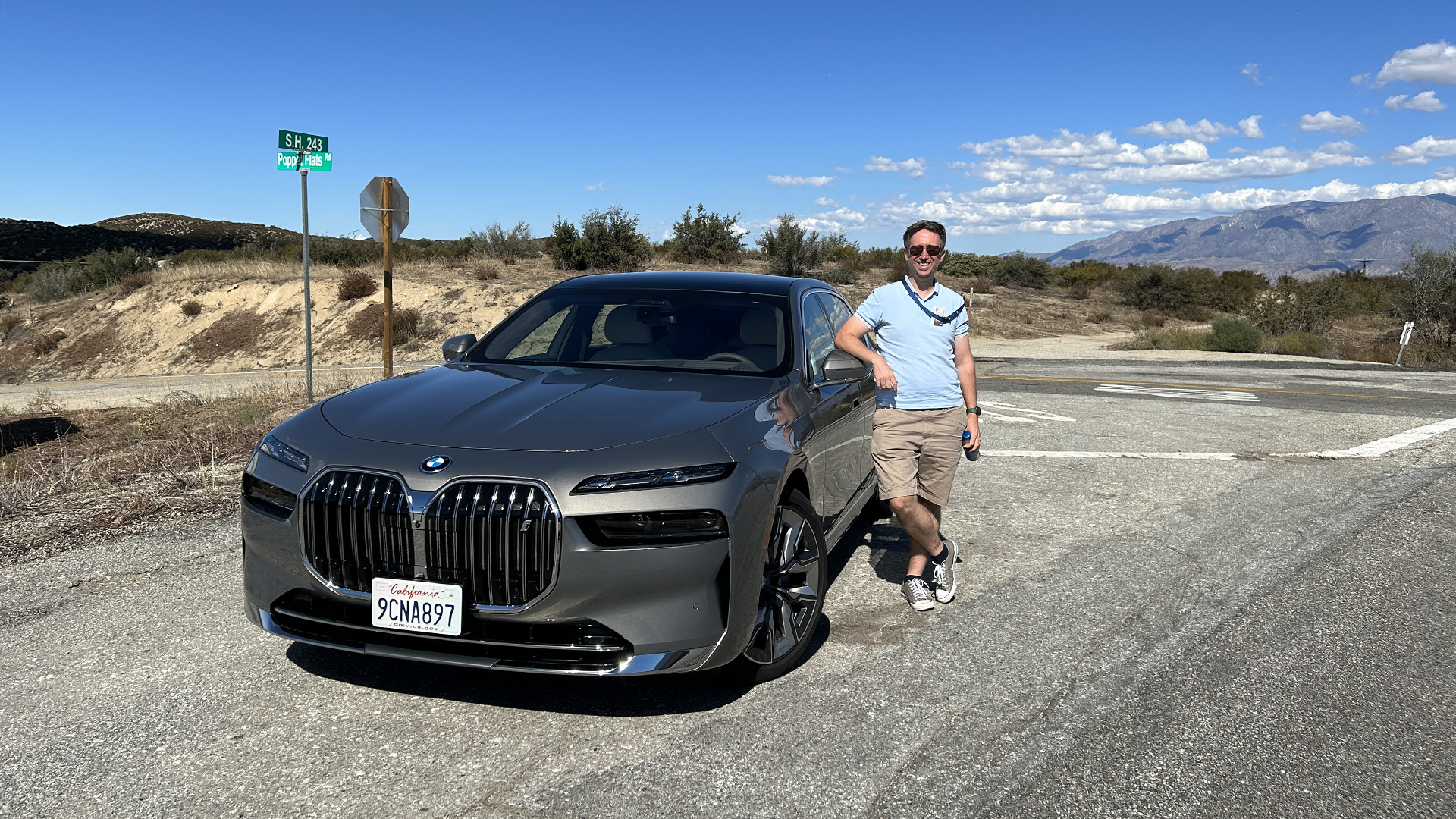
The final word
What I really like about the i7 is that it really is a driver’s car, yet in the back, it’s the ultimate in luxury. It’s the kind of car you could show up to a red carpet event in and then take on a country drive at the weekend.
BMW’s approach to electric is unique in offering the electric model as another engine choice – like petrol or diesel – as opposed to being a completely separate car. This has the benefit of making the transition over to electric easier for the consumer, as well as for the factories.
To compare, I also drove the new 760i xDrive version of the new 7 series (not available in Europe), which uses a V8 petrol engine. Like the i7 it provides 544hp, and has a slightly faster 0-62mph of 4.2 seconds. The grunt from the V8 does feel different, and I did appreciate the raw power behind it, but in all other regards, the car is identical. I feel if you went from one of the milder six-cylinder petrol engines up to the electric i7, you would really appreciate the extra power of the electric, and of course the silence.
The BMW i7 starts from £108,305 / $119,300 / AU$317,917 and is available to build now. The model tested was the BMW i7 xDrive60 Excellence Pro, priced £134,655.
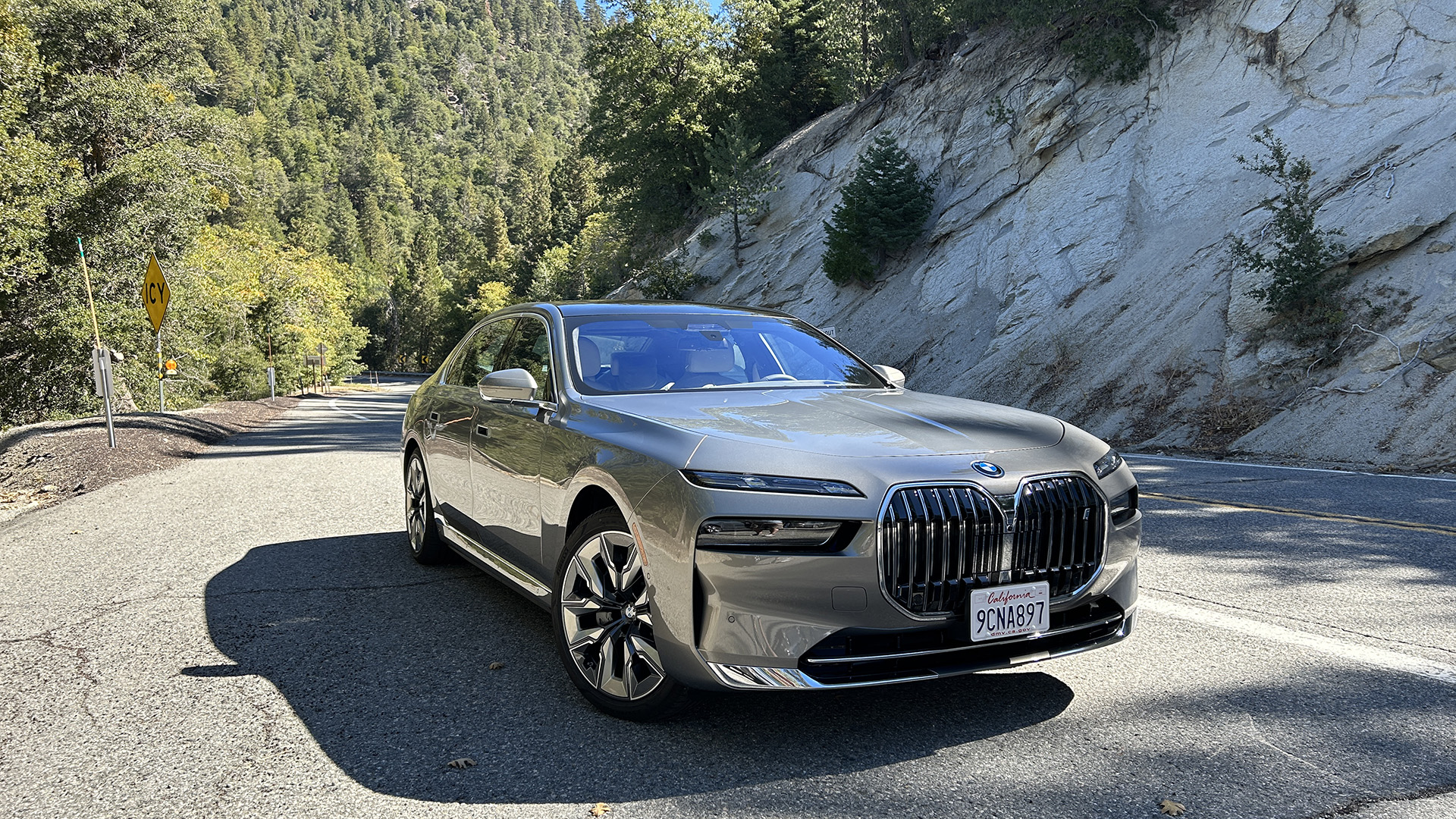
As T3's Editor-in-Chief, Mat Gallagher has his finger on the pulse for the latest advances in technology. He has written about technology since 2003 and after stints in Beijing, Hong Kong and Chicago is now based in the UK. He’s a true lover of gadgets, but especially anything that involves cameras, Apple, electric cars, musical instruments or travel.
-
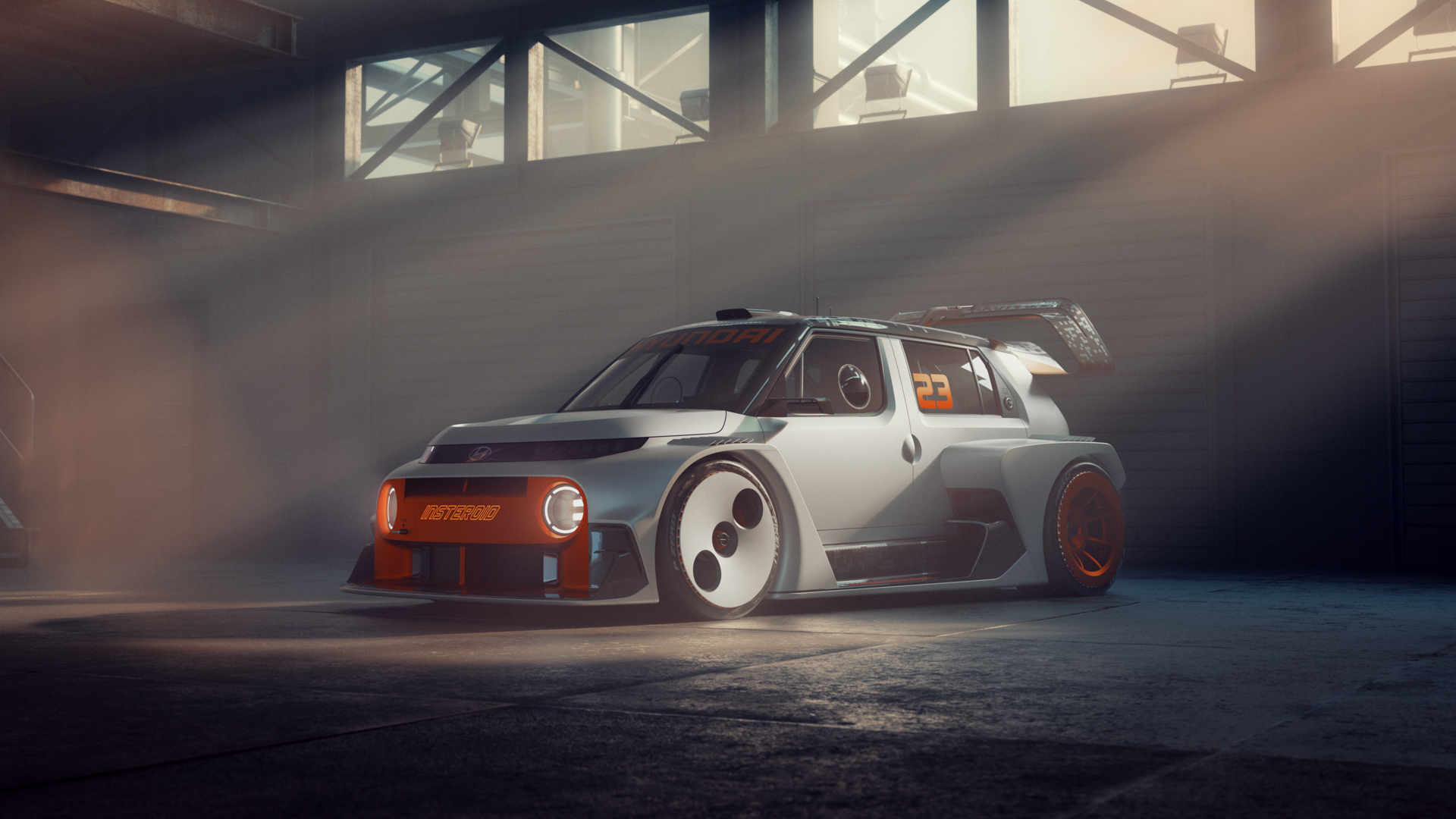 Hyundai goes after Renault 5 Turbo with wild Insteroid concept
Hyundai goes after Renault 5 Turbo with wild Insteroid conceptElectric cars are boring? Not on Hyundai’s watch, they aren’t
By Alistair Charlton Published
-
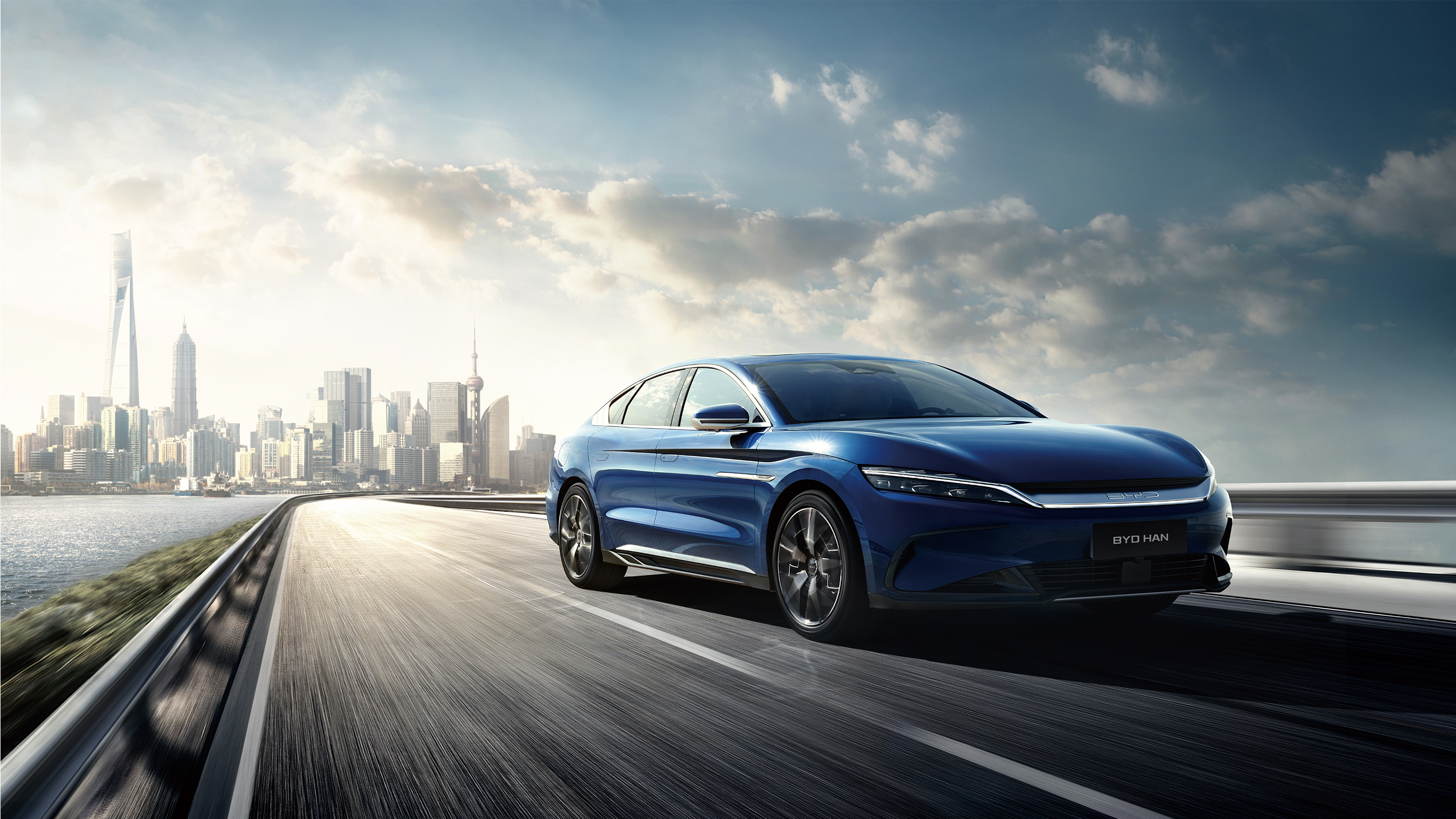 This new EV charger can charge as quickly as filling with petrol at the pump
This new EV charger can charge as quickly as filling with petrol at the pumpBYD's super e-Platform EV charger promises 1,000 kW charging at 1,000 volts
By Alistair Charlton Published
-
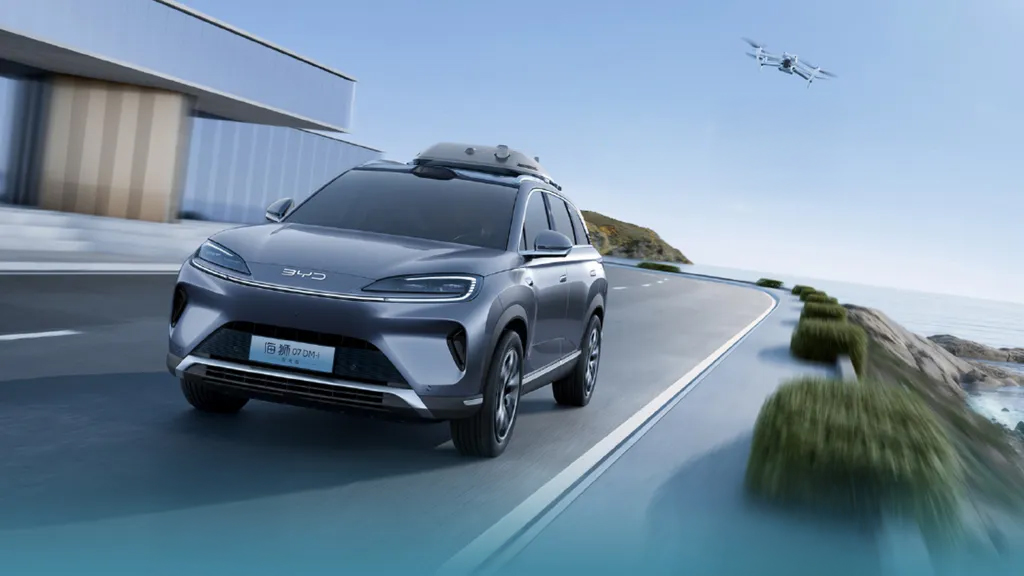 This DJI drone launch pad fits to the roof of your electric car
This DJI drone launch pad fits to the roof of your electric carEV maker BYD has teamed up with DJI to make a roof-mounted drone station
By Alistair Charlton Published
-
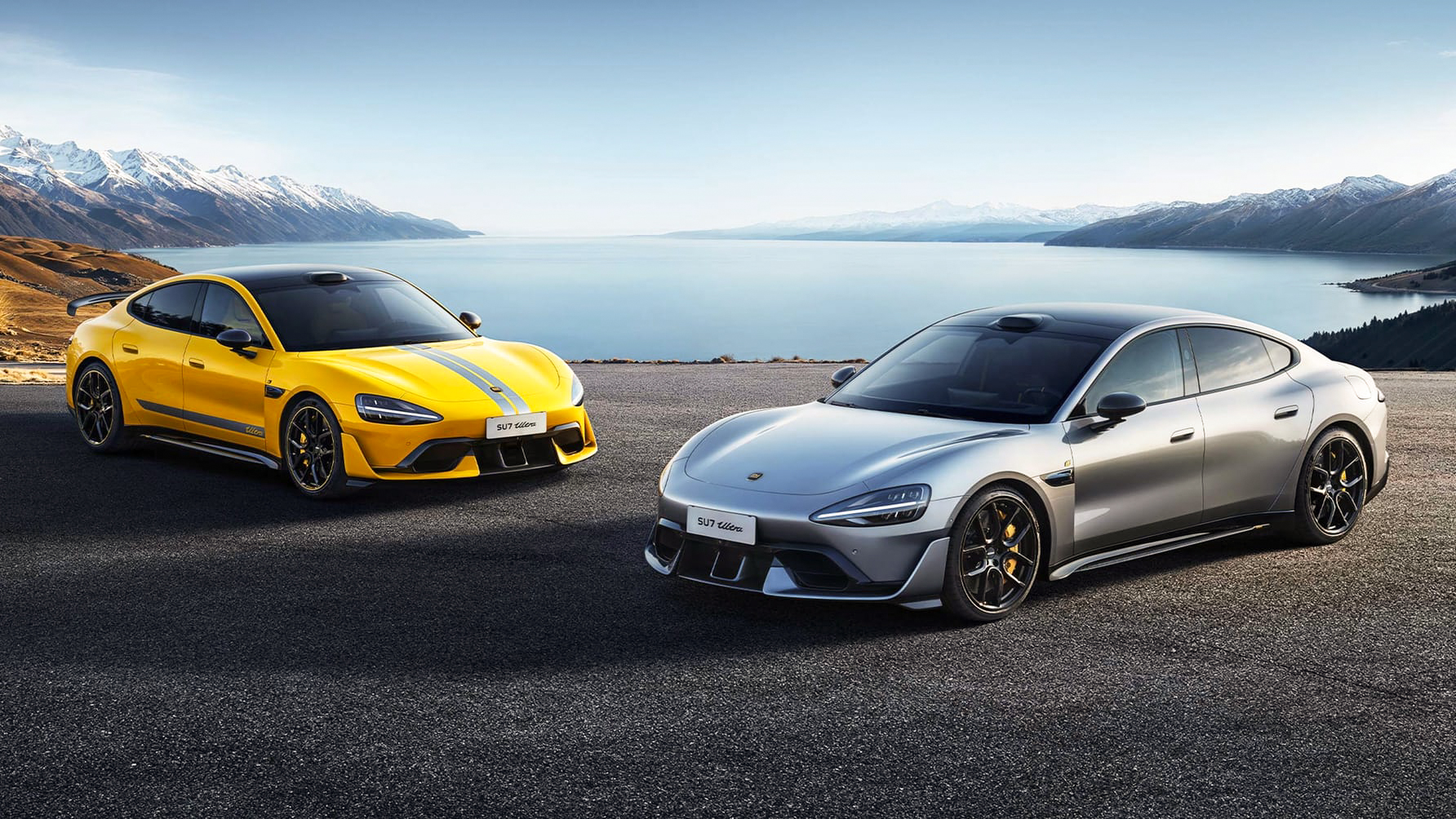 Xiaomi just revealed one of the most interesting EVs of the year
Xiaomi just revealed one of the most interesting EVs of the yearThe Xiaomi SU7 Ultra is a Chinese EV ready to take on Porsche and Tesla
By Alistair Charlton Published
-
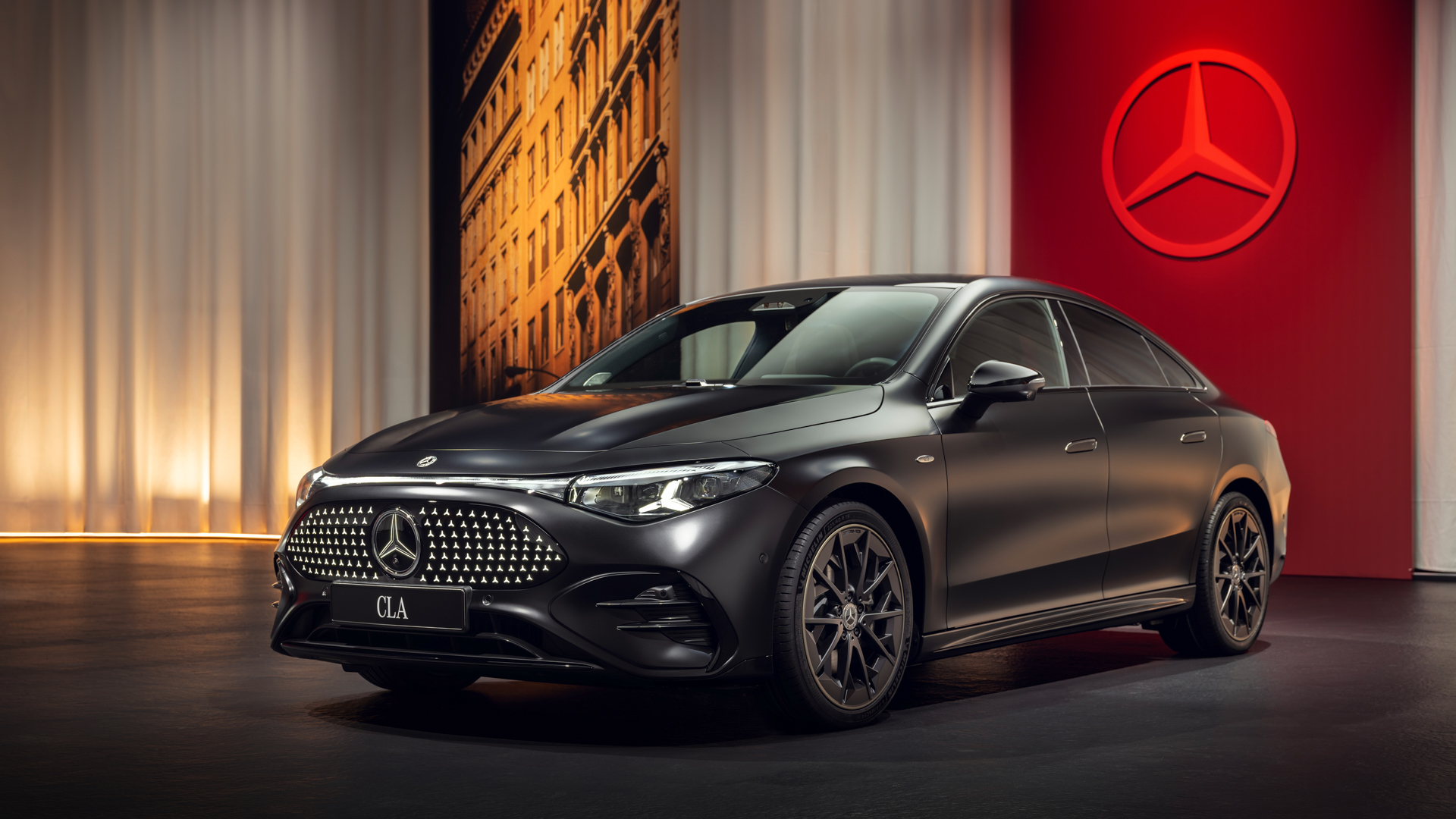 The all-new Mercedes-Benz CLA has AI so smart it wants to be your friend
The all-new Mercedes-Benz CLA has AI so smart it wants to be your friendMercedes’ second generation of electric cars has landed and it's a technology tour de force
By Alistair Charlton Published
-
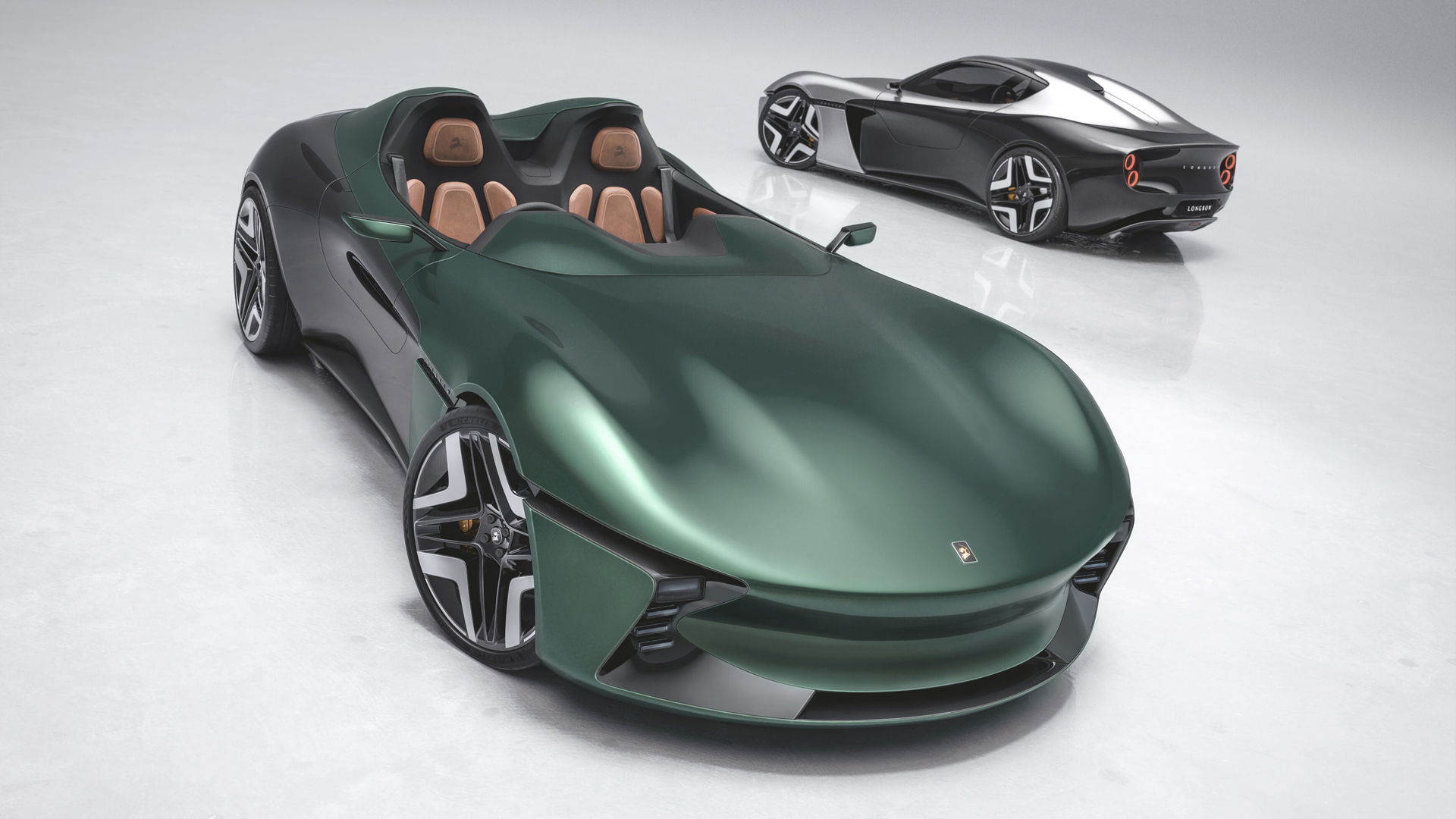 Forget Tesla, this is the best-looking electric sports car we've ever clapped eyes on
Forget Tesla, this is the best-looking electric sports car we've ever clapped eyes onNew British car manufacturer Longbow thumbs its nose at Tesla with an impressive EV sports car
By Chris Hall Published
-
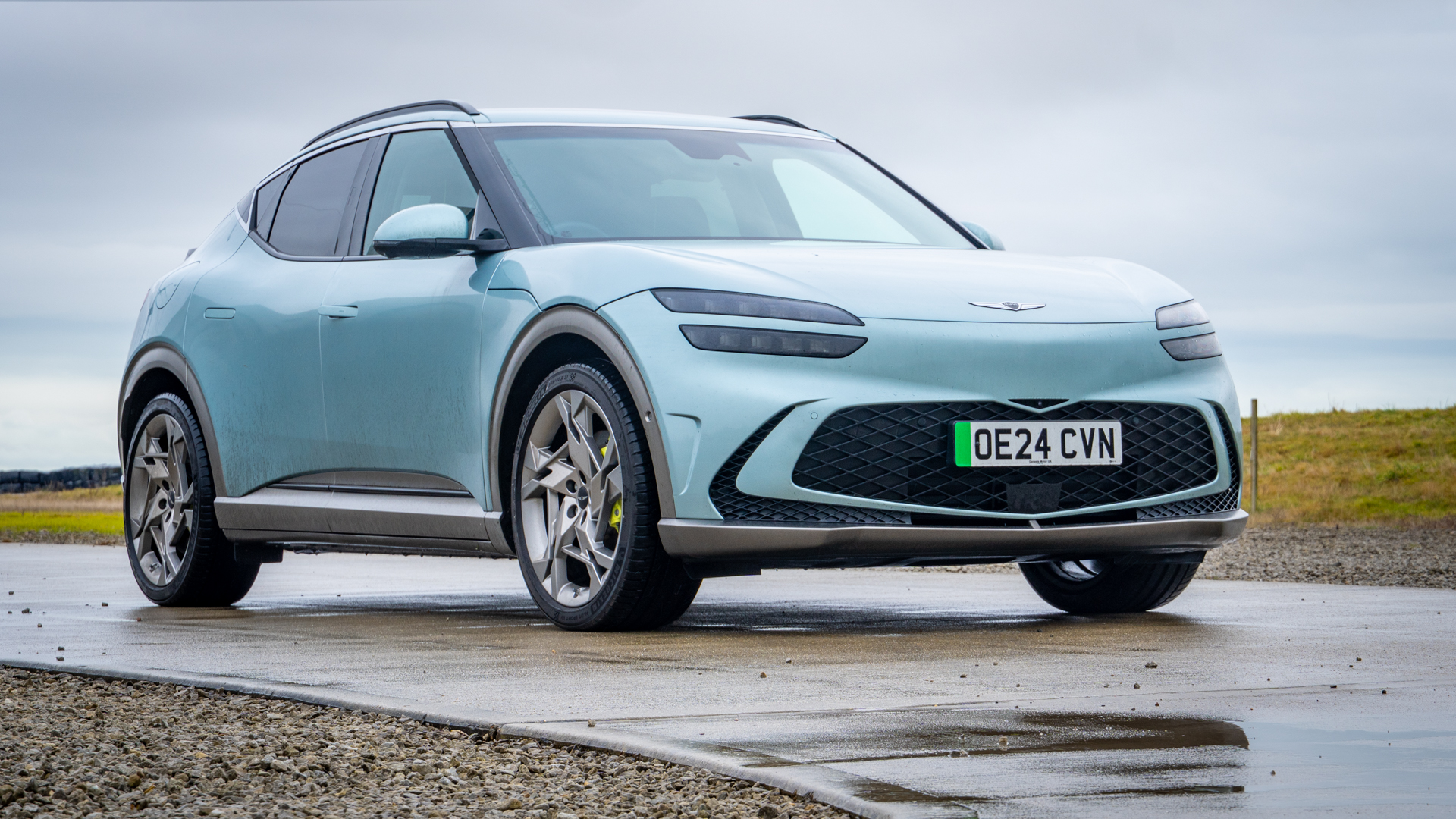 12 things I learnt driving this electric car for six months
12 things I learnt driving this electric car for six monthsHere’s what happened during six months and 4,000 miles with a Genesis GV60
By Alistair Charlton Published
-
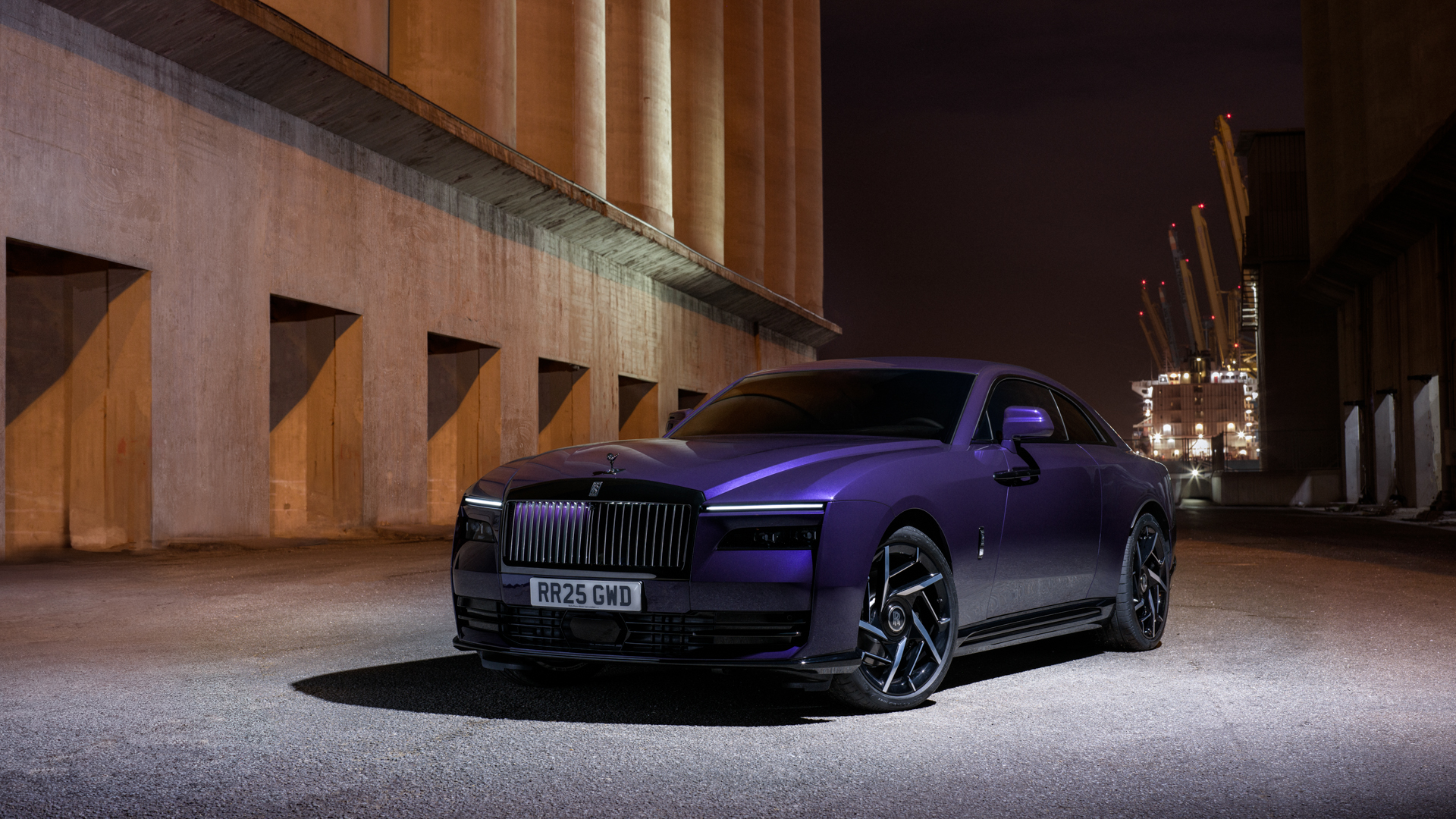 Rolls-Royce gives the electric Spectre a high-performance upgrade
Rolls-Royce gives the electric Spectre a high-performance upgradeThe new Black Badge Spectre is the most powerful Rolls-Royce ever
By Alistair Charlton Published

